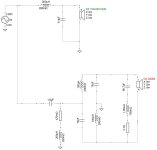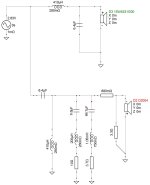Hello, fellow audiophiles. I'm about to build a two way system using Scan Speak 15W/4531G00 and D2004/602000 speakers, Its my first "serious" speaker project (before that I build Visaton Alto system). So anyways, I had some questions regarding XO design. Plan A was to build somewhat regular LR2 crossover crossing at 3100Hz, but it may be a problem with acoustic centers as distance between speakers is larger than wavelength at that frequency. So plan B was to incorporate ladder delay network. Which option in your opinion is more "legit"?
Attachments
Well, simulation shows similar results at least for frequency response, but the ladder delay network introduces some delay as its name suggests (phase changes too, naturally). As far as I heard delay is what you need when acoustic centers is too far apart. But the main question is when do you need to introduce delay? In other words what distance between acoustic centers causes audible problems? It's no need to make a crossover too complex so I am trying to find most reasonable solution.
When you know what phase relationship your design requires, this obviates the situation since any problematic delay represents more phase variation than that. Therefore get phase right and it's good.
Alternately, delay can be added in other ways such as with an asymmetric filter, if you can work with the response that comes with it, which is usually achievable.
Alternately, delay can be added in other ways such as with an asymmetric filter, if you can work with the response that comes with it, which is usually achievable.
On the second picture you have L-pad and 2 tweeter notch filters: are they both necessary? Looked at the tweeter datasheet - it looks reasonably flat. For what frequencies they are?
p.s. Isn't ladder network for delay? Maybe then asymmetric filter is better or the tweeter in a deep waveguide or angled baffle? Random thoughts
p.s. Isn't ladder network for delay? Maybe then asymmetric filter is better or the tweeter in a deep waveguide or angled baffle? Random thoughts
Last edited:
The first notch filter is for tweeter's resonance frequency, the second is for small bump up around 5k (I don't know if it would be present in reality, but vituixCAD gives me one). It may be some "impurities" in frequency response or some fault because of measuring speaker response on baffle whit lack of knowledge what I'm doing. L-pad is just to resolve differences in speaker sensitivity.On the second picture you have L-pad and 2 tweeter notch filters: are they both necessary? Looked at the tweeter datasheet - it looks reasonably flat. For what frequencies they are?
I may try to simulate asymmetric filter, thanks for adviceWhen you know what phase relationship your design requires, this obviates the situation since any problematic delay represents more phase variation than that. Therefore get phase right and it's good.
Alternately, delay can be added in other ways such as with an asymmetric filter, if you can work with the response that comes with it, which is usually achievable.
@PovisS , I have a feeling, that you are little obsessed with the problem(s) that don't exist:
1. That tweeter has resonance freq of 600Hz, which one of the lowest of all the tweeters available. With the values of 2nd order 410uH 6.4uF my wild guess the crossover freq is ~2200-2500Hz depending on sensitivity (you wrote 3100, so even higher) and If you cross it at such freq - there is not much signal at the 600Hz, probably ~-40dB to -60dB, below audibility level, so I am very doubtful you need notch there. And if you build asymmetric filters, most likely you will do 3rd or 4th on tweeter, so the slope will be even higher. That bump on 5kHz could be controlled with smart L-pad selection and woofer slope. This is also my wild guess.
2. I do not think that you are solving a problem that exists: option one is to put acoustic centers as close as possible, maybe little lower crossover and forget that, especially if your tweeter physical dimensions kinda allows that, or there are threads about some magic spacing of 1.2-1.4 wavelengths on tweeter freq, you will find threads about that from our Finnish friends.
1. That tweeter has resonance freq of 600Hz, which one of the lowest of all the tweeters available. With the values of 2nd order 410uH 6.4uF my wild guess the crossover freq is ~2200-2500Hz depending on sensitivity (you wrote 3100, so even higher) and If you cross it at such freq - there is not much signal at the 600Hz, probably ~-40dB to -60dB, below audibility level, so I am very doubtful you need notch there. And if you build asymmetric filters, most likely you will do 3rd or 4th on tweeter, so the slope will be even higher. That bump on 5kHz could be controlled with smart L-pad selection and woofer slope. This is also my wild guess.
2. I do not think that you are solving a problem that exists: option one is to put acoustic centers as close as possible, maybe little lower crossover and forget that, especially if your tweeter physical dimensions kinda allows that, or there are threads about some magic spacing of 1.2-1.4 wavelengths on tweeter freq, you will find threads about that from our Finnish friends.
@svp , thanks for your opinion - you may be right about that second notch filter, that small issue around 5k or so, could be arranged in other ways. But for the resonance frequency notch, I'm think on keeping it as part of design just to be safe, because I heard that some people has the ringing problem even when resonance freq. is that low. What goes for speaker spacing it's already determined and enclosure panels are machined, so the solution is dependent on crossover. I researched about that Finnish sorcery you mentioned and those guys may have some legit points, and conveniently for me with speaker spacing I have, XO point between 3kHz and 3.3kHz would be precisely on the point for 1.2-1.4 wavelengths.
I like to use a resonance notch if it prevents a response peak.
There is no ringing problem. I use some tweeters on their resonance, below and above resonance. No ringing.
There is no ringing problem. I use some tweeters on their resonance, below and above resonance. No ringing.
@svp , thanks for your opinion - you may be right about that second notch filter, that small issue around 5k or so, could be arranged in other ways. But for the resonance frequency notch, I'm think on keeping it as part of design just to be safe, because I heard that some people has the ringing problem even when resonance freq. is that low. What goes for speaker spacing it's already determined and enclosure panels are machined, so the solution is dependent on crossover. I researched about that Finnish sorcery you mentioned and those guys may have some legit points, and conveniently for me with speaker spacing I have, XO point between 3kHz and 3.3kHz would be precisely on the point for 1.2-1.4 wavelengths.
There is only psychoacoustics (read: audiophoolery) when we are talking about such cases. If you have crossover at lets say 2500Hz and it is 3rd order crossover tweeter - at 600Hz it will be -50dB from signal that is 300 times less the signal of lets say at 3000Hz and 100-200 times the signal of crossover freq. YOU CANNOT hear this while listening to music. Period. By some other calculations, the difference is in 100 000 times range. Forget about doing something for 600Hz range. Unnecessary parts will impact more negatively than positively. Here is typical example:
It is ~55-60dB below signal on 3rd order tweeter.
Also tweeter is 1.5dB more sensitive, so you have additional reserve not to burn your tweeter. And it has ~2/3 W power to your woofer, which is plenty.
Another thing: that woofer you use is better be used up to 2.2-2.5kHz, as it is typical 6 inch driver, with pretty big classic non-inverted surround, which may suggest it is not very suitable for quality high freq reproduction. Your tweeter is Fs 600Hz, if you cross it at lets say 2400Hz with 3rd order - that is 2 full octaves from its resonant freq, which is MORE than enough, with 4th order crossover you can cross even lower 2000Hz or even lower than that.
p.s. manufacturer states, that woofer is suitable up to 6kHz, which I doubt, and tweeter from 3kHz, which I also doubt. There are no recommended crossovers in data sheets still.
YMMV, as there are specific driver knowledge, which I don't have
- Home
- Design & Build
- Electronic Design
- 2-way crossover design question

